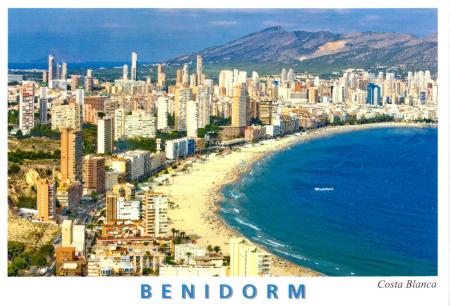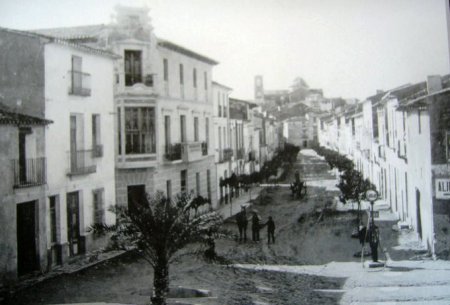“By the end…it was clear that Spain’s spiritual and cultural isolation was at an end, overwhelmed by the great alien invasion from the North of money and freedoms. Spain became the most visited tourist country in the World, and slowly, as the foreigners poured in, its identity was submerged, its life-style altered more in a single decade than in the previous century.” Norman Lewis – ‘Voices of the Old Sea’.
Sixty years ago Benidorm, although not a fishing village as such, was still a modest beach side community, a place of sailors, fishermen and farmers who patiently tended almond, olive, carob and citrus trees. Early visitors would have looked out over a double crescent of virgin golden sand and rolling dunes that stretched out in both directions from a rocky outcrop that divided the two beaches where Benidorm castle is believed to have once stood.
Small fishing boats, the tarrafes, each with four large lanterns to attract fish at night bobbed in the water or lay drawn up resting on the sand. In 1950, Benidorm didn’t attract many visitors and life was difficult, it had no water supply or sewage disposal system and waste was tipped in the sea or simply buried in the earth.
The watershed year was 1954 when the Franco loyalist, Pedro Zaragoza Orts was nominated as town Alcalde, or Mayor and he threw himself into his work and set himself an objective of improving the quality of life in the small town.
In terms of economic potential there wasn’t a lot to work with so he decided to concentrate on the first whiffs of global tourism drifting in from Northern Europe and spreading south along the Costa Brava and he imagined a dream of creating a bourgeois pan-European holiday utopia. Benidorm had sun, it had beaches, it had sea but what it didn’t have was visitors. Few people in Spain enjoyed the sort of standard of living to be able to take holidays in the 1950s, so he needed to attract overseas visitors.
The town had always been popular with veraneos, people who took a few days break to be by the sea, but by the 1950’s, visitors from Scandanavia and Germany were beginning to arrive in greater numbers and staying for a full week at a time, sometimes two! Zaragoza recognised the potential of increased numbers of visitors and quickly created the Plan General de Ordenación, or city building plan, that would exploit that potential.
The plan ensured that every building would have an area of leisure land, guaranteeing a future free of the excesses of cramped construction seen in other areas of Spain and it is the only city in the country that still adheres to this rigid rule. This vision for the future took six years to come to reality, while he waited he piped in domestic water from Polop, fifteen kilometres to the north in the mountains on the road to Guadalest and he ignited the building boom that followed and the flying start that Benidorm achieved in the package tour boom of the 1960s and 70s.
The vision for Benidorm was simultaneously brilliant and exciting and it gave the modern city its modern unique landscape because Zaragoza encouraged vertical construction of dozens of sky scrapers in a deliberate plan to make efficient use of land and to keep the city at ground level spacious and airy with green parks and open spaces and all of the accommodation relatively close to the beaches.
He explained his plan like this; ‘If you build low, you occupy all the space and have a long walk to the beach. If you build high, you can face the sea, and leave room for gardens, pools and tennis courts’. This was in contrast to nearby Torrevieja and on the Costa Del Sol in the south, Marbella where excessive horizontal development led to great sprawling ugly urbanisations that have practically destroyed the coast by burying it under concrete and tarmac. Zaragoza called this urban concentration instead of urban sprawl.
The first developments started at the centre at the rocky outcrop in the twisting narrow streets hemmed in by claustrophobic whitewashed houses, the San Jaime church with its distinctive blue tiled hat roofs, the old town promontory with the Balcon Del Mediterraneo, and pretty Mal Pas beach below and quickly spread east and west along the splendid beaches. Today Benidorm has some of the tallest buildings not only in Spain but all of Europe but the first were fairly unassuming by comparison, the tallest reaching only a modest ten floors or so.
My grandparents were used to living higher up than most people because they lived in a first floor flat but I imagine that they found a high rise hotel in Benidorm really exciting. In the early hotels there was a lot of utilitarian concrete and steel and I am certain that we would consider them quite basic affairs now but they had something that Nan and Grandad were not accustomed to – an en-suite bathroom, because they didn’t have the luxury of any sort of bathroom in their Catford flat.
The first hotels have mostly been demolished and replaced now but I imagine they enjoyed sitting on the balcony of their room and looking out over the inviting Mediterranean Sea because this was a thousand miles and a hundred thousand years away from reality. They were certainly very relaxed because feet on the table like this would never have been permitted at home. We were only allowed into the best front room once a year at Christmas and we weren’t allowed to touch anything so I am surprised by this.
Not everyone approved of the changes however and Norman Lewis may have had Zaragoza Orts in mind when he wrote in ‘Voices of the Old Sea’:
“The ancient handsome litter of the sea front had possessed its own significance, its vivacity and its charm. A spirited collection of abandoned windlasses, the ribs of forgotten boats, the salt wasted, almost translucent gallows on which the fish had once been dried, the sand polished sculpture of half buried driftwood … was now abolished at a stroke”
Benidorm, Plan General de Ordinacion
Benidorm, The War of the Bikini
Benidorm 1977 – First impressions and the Hotel Don Juan
Benidorm 1977- Beaches, the Old Town and Peacock Island
Benidorm 1977 – Food Poisoning and Guadalest
Click on an image to scroll through the pictures…





















A super insight into life and times in Benidorm back in the seventies and before.
‘If you build low, you occupy all the space and have a long walk to the beach. If you build high, you can face the sea, and leave room for gardens, pools and tennis courts’. This was in contrast to nearby Torrevieja and on the Costa Del Sol in the south
It’s important to point out that although Marbella may have been the home of the rich, famous and infamous, Torrevieja in contrast was still very much a fishing and salt producing village of less than 12,000 residents, back around 1977.
It’s only since the early 1990’s that tourism became popular in Torrevieja and by that time, the low level construction was very much the order of the day. For ten years, local government have been trying to make changes to local laws, without much success but now possibly skyscrapers, of only 20 floors, may be possible.
Thus there was no need to build upwards in Torrevieja 30 years ago as there was neither a population nor a tourist trade to warrant it, while Marbella probably should have been.
Just an observation. Keep up the great Blog.
LikeLike
That’s interesting, thanks for this information
LikeLike
OOh it’s a Benidorm byth about the fishing village. Benidorm long time ago was already a nice resort where people used to come and have sunbaths and practice water sports so you are absolutely correct.
LikeLike
Pingback: PAISAJES: Playa (Alicante) | Vidas En Color
Pingback: A to Z of Postcards – B is for Benidorm | Have Bag, Will Travel
You inherited your wanderlust from your grandparents
LikeLike
Entirely possible!
LikeLiked by 1 person
What an interesting post. I think I visited Benidorm only the once.
One of my daughters and her ex partner lived in Torrevieja for a couple of years until their business was sold. I remember it as a place where the Spanish visited more than the English. Strangely, it was only yesterday that I was thinking about the area and in particular the Salt farms.
LikeLike
My sister has a place near Torrevieja so I know it well.
LikeLiked by 1 person
Interesting to read this positive history of Benidorm which has had such a bad press in recent years. I’ll admit to having only passed through, but friends who’ve been there say it has so much more to offer than just sun sex and sand. I’ll have to give it a try after all!.
LikeLike
I think it is ok. My brother in law said that he would never go but I insisted and he had to concede that it is ok and that he would go back. There are worse places. Malia in Crete and Kavos in Corfu spring to mind.
LikeLiked by 1 person
Right. We’ll stop off next time we’re in the area.
LikeLiked by 1 person
Enjoyed the read, Andrew. I’d never heard of Peacock Island, and I wondered if the Bahia was still running.
LikeLike
I just checked and it is sailing today. Most likely not exactly the same boat that I sailed on 45 years ago.
LikeLike
🤣💟
LikeLike
A fascinating history of what seems a nightmare venue to me
LikeLike
Actually Derrick it is not so bad. I went there in 1976 and it was awful, just as you might imagine it but I have been back quite recently (during the Winter, I confess) and it was really rather nice.
LikeLiked by 1 person
There are so many sides to the story of tourism anywhere. The locals don’t like losing their old lives. But they do quite like the income that tourism brings. But that income isn’t spread evenly amongst the locals.
LikeLike
Old folk will lament the passing of the old ways but younger people welcome progress and opportunity. It is the way of things.
LikeLike
I have always found the mixture of modern buildings and the beach right next to them quite striking.
LikeLike
Quite so.
LikeLike